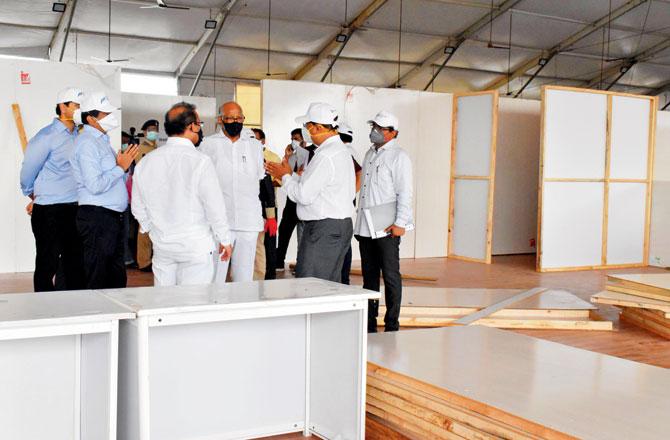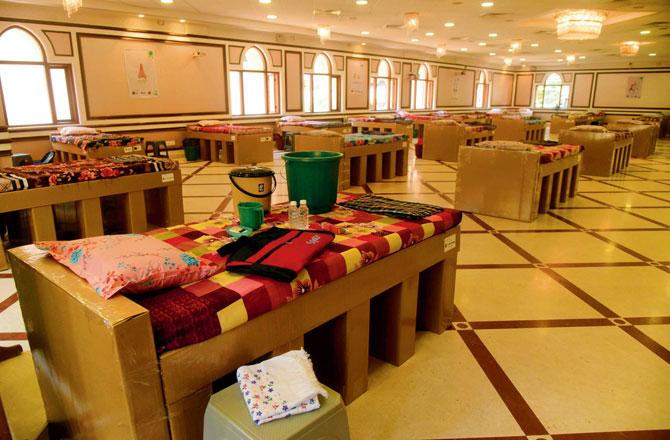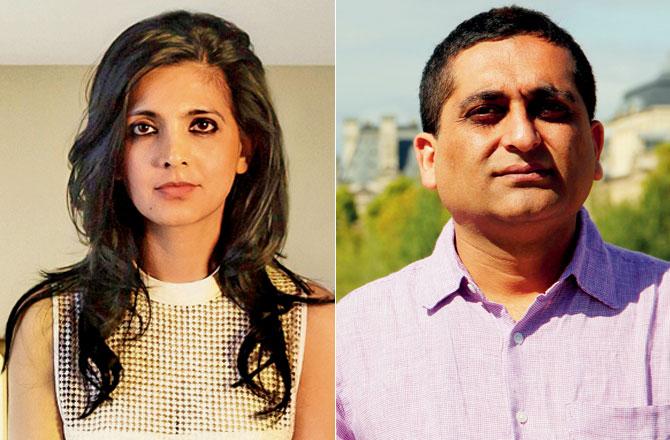To combat shortage of space in hospitals, a team of urban planners from an Ahmedabad university are transforming vacant buildings in Mumbai into sustainable and scalable COVID-19 quarantine centres within record time

MLA Amin Patel arrives at St Xavier's College with BMC officials to oversee the ongoing construction
Dr Miniya Chatterji, director and founder of the centre of sustainability at industrialist Ajay Piramal-led Anant National University, Ahmedabad, has been researching vacant infrastructure across India for about a year. The study is a deep dive into why 7.5 per cent of all residential buildings in the country are lying empty, and how they can be put to better use. It's almost serendipitous that Chatterji, a PhD holder from Harvard University and Columbia University, will now be channelling this knowledge for a new purpose: to develop COVID-19 recovery facilities to ease the pressure on overburdened healthcare systems.
ADVERTISEMENT
"With the government struggling to contain and treat the rising number of patients, we realised there is a mammoth need to scale up temporary hospitals and provide affordable, out-of-the-box solutions," Chatterji says in a telephonic interview from her home in Goa, where she lives with her husband and two-year-old son.

One of the iconic wedding halls in South Mumbai, Najam Baug is equipped with centralised AC, CCTV cameras, elevators, clean washrooms, and special amenities for the differently-abled, making it the perfect location for a temporary COVID recovery facility. Pics/Suresh Karkera
After having created such centres in Kerala to cater to residents returning from overseas, a 100-bed facility at Dongri's Najam Baug, a community centre for the Dawoodi Bohras, is her pilot project for Mumbai. This will be followed by 100 beds in the neighbouring Kesar Baug and 250 beds at St Xavier's College, CSMT. While the former is nearing completion and will start admitting patients from Monday, the others are under prep.
The move comes after the varsity, led by provost Dr Anunaya Chaubey, submitted a robust proposal to the Prime Minister's office as well as to private builders to rapidly scale up COVID-19 recovery facilities by utilising existing hard infrastructure buildings—government-owned, community-owned, or private—and refurbish them to provide recovery facilities with ICUs. These would be set up within a span of three to five days with no immediate cost to the government. In April, the health ministry's joint secretary Lav Agarwal announced that India needed 586 hospitals across the country as dedicated COVID-19 hospitals, and over one lakh isolation beds. This too may not be enough. According to the BMC, the city has more than 4,270 beds as of May 10, across dedicated COVID-19 health centres and hospitals in the city.

The facility will have 250 beds for mild and asymptomatic patients
"At the time of submitting the plan, there were only 300 patients in India, but we knew that the number would rise. Social distancing is not viable in a country like ours because one of six urban dwellers live in slums," says Chatterji. The team brought together a panel of doctors, urban planners and equipment suppliers to draw up a list of what was needed. The reference point was field hospitals, which were common during World War II. "Ventilators were the first thing that came up, but with more brainstorming, we realised that what we truly needed is very good oxygen supply, so, we brought it down to only what is needed," she says. To encourage builders to give up spaces, the team also proposed a PPP (public-private partnership) model that can compensate private owners/developers of community and marriage halls by offering them free ticket deposit receipt (Transfer of Development Rights or TDR) for their next project (with a cap equalling the TDR value of the current building used for COVID-19 facility).
The Najam Baug centre is equipped with specially crafted, laminated corrugated cardboard beds, along with side tables to keep other medical equipment. The nifty beds can be disinfected and have the capacity to hold seven people. They come with an assembling manual. "The beds might look simple from the outside, but smart engineering has gone into their making," says Dhaval Monani, associate professor and director of affordable housing at the university. Their research showed that whatever was available in the market was not optimal because of the high costs involved. "We need mattresses coated with rexine to ensure no infected matter seeps in, which costs between R15,000 to R18,000 per bed. A side bed would be another R3,000, which is when we started looking at alternatives," he adds. Their next step was to involve local stakeholders. Monani and his team went to manufacturers in Meerut, Rajkot and Hyderabad and sourced mattresses, which are the same quality as the medical ones, but at 50 per cent of the original cost.

The specially crafted, laminated corrugated cardboard beds at Najam Baug can hold up to seven people
With the core team scattered across remote locations, their on-ground support system in Mumbai included members from Habitat for Humanity, a non-profit organisation that builds homes and provides housing-related services to low-income families across India. "We packaged the material and gave them detailed setting-up instructions."
According to MLA Amin Patel, Najam Baug will primarily focus on CC2 (non-critical patients). One of the iconic wedding halls in South Mumbai, the space is equipped with centralised AC, CCTV cameras, elevators, clean washrooms, and special amenities for the differently-abled, with rents that cost R3 lakh upward for single use. It will now have gendered wards for patients. "After the lockdown, the BMC visited the centre and felt it would be ideal to set up a temporary hospital here, given the paucity of vacant spaces in B Ward, which includes Dongri, Bhendi Bazaar and Umarkhadi," he says. The Najam Baug community website states that the structure was built in 1886 by entrepreneur Ebrahim Noordin and his brother-in-law, Abdoolally Rajabally, at a time when Mumbai had few centres for community activities. "By the end of the 1990s, Najam Baug started showing its age. The family of Mulla Abdeally Noordin then undertook reconstruction, after razing the existing edifice. The foundation of the new Najam Baug was laid by Syedna Mohammed Burhanuddin in 2003. Work was completed by 2005," it reads.

Dr Miniya Chatterji and Professor Dhaval Monani
Chatterji says community halls are the primary targets when it comes to repurposing facilities as quarantine sites. "We had informed the BMC that schools and colleges should be left out of the ambit, because the idea is to take up places which don't need dismantling in the foreseeable future. If the curve flattens, we might want to start educational institutes," she says. But an overcrowded city with 31,700 people per square km, left them with little choice.
The St Xavier's College facility is being sponsored by the Godrej Group, with Congress leader Milind Deora backing the effort. He was one of the first to get in touch with the university to build more quarantine centres for the city. "The BMC needed help with South Mumbai, so we stepped in. The cost per bed is approximately R5,000, including GST and the Godrej family was happy to help. If we identify more structures, we have the bandwidth to create more facilities," he says. Also in the pipeline is a 250-bed facility at MP Mill Compound in Tardeo. Deora is also toying with the idea of a mobile screening bus equipped with an X-ray machine, which can go around slum areas to screen residents. Chest X-rays are often used to detect infections in the lungs.
Meanwhile, Nitin Arte, B-ward assistant municipal commissioner, is in the process of identifying more structures to create temporary medical facilities. "Fortunately, the cases in this ward are under control. At present, there are 160 cases. We have seen a great recovery rate of 50 per cent."
Catch up on all the latest Mumbai news, crime news, current affairs, and a complete guide from food to things to do and events across Mumbai. Also download the new mid-day Android and iOS apps to get latest updates.
Mid-Day is now on Telegram. Click here to join our channel (@middayinfomedialtd) and stay updated with the latest news
 Subscribe today by clicking the link and stay updated with the latest news!" Click here!
Subscribe today by clicking the link and stay updated with the latest news!" Click here!






